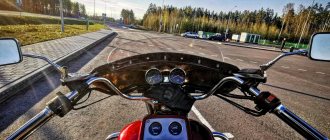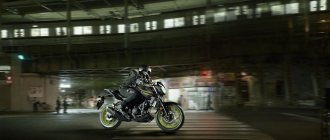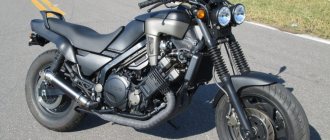- motorcycle model, Yamaha brand,
The Yamaha FJ 1200 sports touring motorcycle model appeared in 1986 as a successor to the Yamaha FJ1100 model. The motorcycle was focused mainly on foreign markets (Europe and the USA), but in 1991 it was officially sold in Japan. Also noteworthy was the fact that the Yamaha FJ1200 model produced at that time a record power of 130 hp. (among Japanese air-cooled engines) and became the first Japanese motorcycle with ABS as an option.
The model was based on an in-line 4-cylinder air-cooled engine, taken from the FJ1100 and increasing its volume to 1188 cc. cm. As a result, the maximum power rose to 130 hp, and torque - to 108 Nm. Japanese versions were "strangled" to 97 hp. European versions produced from 96 to 130 hp.
Features of the Yamaha FJ1200 include a steel frame, adjustable suspension, hydraulic clutch, 5-speed gearbox, versions with ABS (from 1990 - FJ1200A), a 22-liter fuel tank and 258 kg curb weight.
Bike features
Here's why the Yamaha FJ 1200 outperforms many of its competitors:
- Convenient for traveling together due to its impressive dimensions;
- stability on the road, resulting again from size and weight;
- low cost compared to top sports tourists.
Of course, this model cannot be called the best representative of the class. There are many reasons for this, and one of the undeniable ones is that the engine is too voracious, consuming at least 6.5 liters of fuel during calm, measured movement along a country road. What can we say about the mixed cycle, the city and the like.
Review of the Yamaha FJ 1200 motorcycle
Well, I’ve been riding this device not long ago, I switched to it from Java 638... The jump turned out to be powerful... About the device, my first impressions were... HURRAY!!!! It handles, handling is 10 out of 10, the brakes are simply beasts... Even braking with the rear wheel is effective...
Gasoline consumption is a little bit harsh, or more specifically 8-8.5 liters in the city and about 7 liters on the highway, but what is the volume))) My speedometer was up to 180, I accelerated to 211 km/h using the electronic speedometer, but I have a motorcycle for the domestic market, those that were exported had a speedometer of up to 260 km/h...
In the city it is not a very convenient device due to its weight of 270 kg dry weight, but on the highway there are no equals))), it is stable, you don’t get tired on long drives, it is controlled very easily and without strain, although if you just ride it on foot, it is quite heavy... In short, the device is super, you won’t regret it and it’s very rare, so at most rallies there won’t be anything like it))) We have 2 of mine in Odessa and one of the traffic cops... I recently met him, he is also very happy with the car...
At the beginning of this season I purchased this wonderful device. Moreover, I took it in addition to my four hundred (XJR) exclusively for long-range driving. I was very pleased with the sweeping five-speed gearbox. For example, in a four-hundred car, in order to quickly fly away from a traffic light, leaving fussing motorists behind, you had to actively click the gearbox. On the “Fiji” you only need to make two shifts without even revving the engine too much, and the speed is already about a hundred and all that “compot” that the cars induce is left far behind. By the way, I carried out a very instructive experiment: I was driving along the highway, in fifth, at a speed of a hundred and tried to unscrew it completely. Mentally, I was already preparing for a slow increase in speed, however, before I had time to count to “ten”, the speedometer exceeded two. Hence the conclusion: the last gear is very accelerating. The wind protection works great at such speeds, you feel like you’re at home. At four hundred, at 160 the head is already starting to come off. It holds the road superbly, the weight and long wheelbase do their job. Fuel consumption is just very pleasing. I also have about 6.5. The device is certainly massive, but it cannot be called clumsy. The turn-out is very good, although the steering is a little heavy. In general, such a mass is a plus only on the highway; in all other cases it is a minus. I’m incredibly interested in how the Japanese, these little people, put it on the center stage. This model was probably designed for sumo wrestlers. The brakes also seemed a little weak to me. I have a model with ABS, but for some reason the previous owner disabled this system. Of course, I would like to revive the ABS, but I don’t have a manual for this particular model. But I’m not ready to climb there on a ball yet. By the way, I would like to hear feedback on the operation of the ABS. Indeed, our model is quite rare. This is probably partly explained by the years of graduation, and young people are more and more engaged in “cafe racing” from cafe to cafe than in serious trips. And they don’t need such a cruiser for this.
Mot is simply a miracle! It’s not for nothing that it took so many years to be produced. The fact that there are few of them is only because the owners (over the hill) don’t really want to part with him. And in our country, it’s not fashionable, in the forefront, there are bullets and buzzers. Although this model is still supported by the official Yamaha support program. So everything is produced in bulk for her. You still have to try to kill the FJ, the engine is recognized as one of the best air-oil large-volume engines. It’s not for nothing that the engine was put into production again in the XJ 1200 in 2002. In Europe there are a lot of clubs for FJ 1100-1200 fans, and in fact, in some countries this device still serves in the police service to this day. This is my second time and I haven’t had any problems. I don’t recommend fooling around with it, even when driven at low speed, its weight can easily break bones (I’ve been through this), and besides, if you just drop it on its side, then there will be a problem with how to start it. When filling up, gasoline pours the contents from the float chambers of the carbs into the cylinders and cylinders. Wait until it stops, and then it will start in half a click. In general, the bike is very decent for moderately long-distance speeds, and even in Moscow traffic jams I can’t say that I got tired on it. I even managed to lie down and sleep on it, placing it on the central footrest; oddly enough, I never fell over in my sleep, which I’m surprised at! )))) I like his sound, ))) I often get asked this question. Is it diesel? I always say as a joke that Yes!
Dimensions and weight
As for weight, this representative of the class, although not out of the norm, is definitely one of the heaviest. Even its dry weight is 250 kg, let alone loaded, if its tank volume is 22 liters. The wheelbase is 1490 mm, but the seat height is average and reaches only 780 mm.
FJ1100[edit]
Yamaha produced the FJ1100 for the 1984 and 1985 model years. This class is characterized by maintaining sportiness while integrating more street-friendly ride characteristics, including good agility, as well as long-distance comfort, such as a more upright seating configuration designed to reduce back strain and a large fairing to reduce fatigue from wind resistance. The emphasis is on balancing utility and sport rather than a pure performance focus. The car was noticeably narrower than many of its contemporaries, Yamaha achieved this by placing the generator behind the cylinders instead of the more usual position at the end of the crankshaft. [1]
1984 FJ1100 with custom seat
Chassis and brakes
Disc brakes do a good job. The rear uses a single disc, while the front uses a pair. The calipers vary, with four-piston units at the front of the bike and a two-piston option at the rear.
The rear suspension is pendulum and has a monoshock absorber. The front telescopic fork has a fairly large stroke of 150 mm. The tubular frame is made of steel, and the wheel rims are, of course, cast, as befits sports touring models.
Brief history of the model
1986 - start of production and sales of the Yamaha FJ 1200 model. First generation. Model: Yamaha FJ1200S /FJ1200SC (USA). Factory designation: 1UX/1WJ.
Model: Yamaha FJ1200 (Europe). Factory designation: 1WH (France), 1YK (Switzerland), 1XJ (Germany), 1TX (UK).
1987 - no significant changes. Model: Yamaha FJ1200T /FJ1200TC (USA).
Model: Yamaha FJ1200 (Europe). Factory designation: 1WH (France), 1XJ (Austria), 1TX (UK).
1988 - second generation of the model. This year's models are only available in Europe. The Yamaha FJ 1200 loses its Anti-dive system, gets new 4-piston front calipers and 298 mm ventilated brake discs, a 2-piston rear caliper, digital ignition, a fuel pump and a 17′ front wheel. Model: Yamaha FJ1200 / FJ1200U (Europe). Factory designation: 3CY1 (Switzerland), 3CX1 (France), 3CV2 (Spain), 3CW1 (Austria), 3CV1 (UK), 3GP1 (other European countries).
1989 - no significant changes. The model is again available on the US market. Model: Yamaha FJ1200W /FJ1200WC (USA). Factory designation: 3SK.
Model: Yamaha FJ1200 / FJ1200W (Europe). Factory designation: 3GP2.
1990 - third generation of the model. The appearance of modifications with ABS (FJ1200A). Model: Yamaha FJ1200A /FJ1200AC (USA).
Model: Yamaha FJ1200 / FJ1200A (Europe). Factory designation: 3CY2 (Switzerland), 3CX2 (France), 3CV7 (Spain), 3CW2 (Germany), 3CV6 / 3GP3 (other European countries).
1991 - The Yamaha FJ1200 is also available in the Japanese market. Instead of an aluminum pendulum, the model gets a steel one. Model: Yamaha FJ1200B /FJ1200BC (USA). Factory designation: 4AH.
Model: Yamaha FJ1200 / FJ1200A / FJ1200AD / FJ1200B (Europe). Factory designation: 4BS1 (Switzerland), 3YY1 / 3YY2 (France), 3XW4 (Spain), 3YA2 / 3YA1 (Germany), 4BS2 / 3XW2 / 3XW1 / 4CR3 / 4AH3 / 4CC1 (other European countries).
Model: Yamaha FJ1200 / FJ1200A (Japan). Factory designation: 4CC1 / 4CC2.
1992 - no significant changes. Model: Yamaha FJ1200D/DC, FJ1200AD/ADC (USA). Factory designation: 4CR.
Model: Yamaha FJ1200 / FJ1200A / FJ1200D (Europe). Factory designation: 3YY3 / 3YY4 (France), 3YA3 / 3YA4 (Germany), 3XW6 (Spain), 4BS3 / 4BS4 / 3XW5 / 3XW7 / 4AH6 (other European countries).
1993 is the last year of sales of the model in the USA. The Yamaha FJ 1200 is being discontinued but is still available on the European market. Model: Yamaha FJ1200AE/FJ1200AEC (USA).
Model: Yamaha FJ1200 / FJ1200A / FJ1200E / FJ1200AE (Europe). Factory designation: 3XW8 (Spain), 4CR6 / 4AH9 (other European countries).
1996 was the final year of Yamaha FJ1200 sales in the UK.
Yamaha A-S1200 stereo amplifier specifications
| output power | 2 x 90 W (8 ohms, harmonic distortion 0.07%), 2 x 150 W (4 ohms, harmonic distortion 0.07%) |
| Damping factor | more than 250 |
| Frequency range | 5 Hz – 100 kHz (± 3 dB) |
| Inputs | 3 line, tape input, Phono (MM/MC), power amplifier input |
| Exits | to a recording device, Pre-Out, to 2 pairs of speakers, to headphones |
| Additionally | trigger input, control system input/output, USB (service), ground terminal |
| Harmonic distortion | 0.005% (linear input) |
| Signal to noise ratio | 93 dB (Phono MM), 110 dB (line input) |
| Sensitivity | 200 mV (linear), 3.5 mV (MM), 0.15 mV (MC) |
| Tone control range | ± 9 dB (LF, HF) |
| Transformer | 625 VA |
| Dimensions (WxHxD) | 435x157x463 mm |
| Weight | 22 kg |
Description of the Yamaha A-S1200 stereo amplifier
The integrated stereo amplifier Yamaha A-S1200 is built according to the classic canons of Hi-Fi, not only outside, but also inside. If the classic design of the device is obvious - large dimensions of the case, dial indicators of the signal level, large controls, then its filling can be called classic in terms of its thoroughness. Perhaps, such a serious approach to the design of a stereo amplifier can now be found in models of a much higher price category, and this commands respect. In addition, the Yamaha A-S1200 is an analog audio device, and all digital sources in a system based on this unit can only be external. At the same time, the Yamaha A-S1200 has very flexible switching, which allows you to assemble a wide variety of kits based on it.
The amplifier has taken very serious measures to combat any interference, both electrical and mechanical. The Yamaha A-S1200 anti-vibration chassis is mounted on special damping mounts, and the placement of all massive components is designed to minimize their center of gravity. The grounding in the amplifier is made with a large cross-section wire to effectively eliminate interference. The amplifier circuit uses selected audiophile grade components.
The device develops an output power of 90 W per channel (with a load of 8 ohms) or 160 W when connecting 4-ohm speakers. Such indicators indicate a fair amount of energy provided by the Yamaha A-S1200 power supply. This is not surprising, since it is built on the basis of a powerful proprietary toroidal transformer, and the output amplifiers in this model are built on discrete components. The channel amplifiers are made on separate boards, with their symmetrical placement in the housing.
The Yamaha A-S1200 is equipped with three line inputs, a line level input and output, which can be used, for example, to connect a tape recorder. The amplifier also has a preamplifier output and a direct input to the terminal. The Yamaha A-S1200 is equipped with a high-quality built-in MM/MC phono stage. There are proprietary screw terminals for connecting two pairs of speakers, as well as a headphone output.
Yamaha FJR1300
Unlike its predecessor FJ1200, which was an upgraded version of the FJ1100, the new Yamaha FJR 1300 sports tourer was designed from scratch and went on sale in 2001 to replace the previous model.
The motorcycle received a completely new 4-cylinder liquid-cooled engine with a volume of 1298 cm3. Its power was 146 hp. - 16 hp more than the previous model, but the torque was increased by almost 30% - up to 130 Nm. At the same time, maximum power indicators were achieved already at 7000 rpm. An improved TCI ignition system and Mikuni injector also made it possible to achieve fuel efficiency - despite the increase in volume and power, fuel consumption remained the same as that of the FJ1200.
The transmission used was a 5-speed gearbox. But since 2006, versions with semi-automatic transmission have appeared, and since 2016, a new 6-speed transmission has been installed on motorcycles.
Throughout the history of its production, the motorcycle has been constantly updated and modernized. The most large-scale restylings took place in 2006 and 2013.
In 2006, the design was changed - the radiator received a more curved shape, the dashboard was changed, and adjustments for the windshield and ventilation moments appeared. In addition, the gear ratio was changed, versions with semi-automatic transmission appeared, and ABS became standard equipment for both European and American models.
Since 2013, all motorcycles have received more advanced aerodynamic elements, new LED optics, and an improved glass adjustment mechanism. In addition, the engine power was increased by almost 150 hp, a new electronic throttle, cruise control and TCS electronic traction system were installed.
15.10.2016
Links[edit]
Notes[edit]
- ^ a b Haynes 0.5
- Haynes 2.4
- Clymer p.216
- Haynes 5.2
- Haynes 2.5
Bibliography[edit]
- Ahlstrand, Alan and Haynes, John H. Yamaha FJ1100 and 1200 Fours '84 - '96
. Sparkford, UK: Haynes Publishing, 1996. ISBN 1-85960-229-0. - Clymer, Yamaha FJ1100 and FJ1200 1984–1993
. Overland Park, Kansas. Intertec Publishing, second edition 1996. ISBN 0-89287-605-0. - Brown, Roland The Definitive History of Fast Bikes
. Bath, UK: Parragon Books, 2004. ISBN 1-4054-3732-4.







